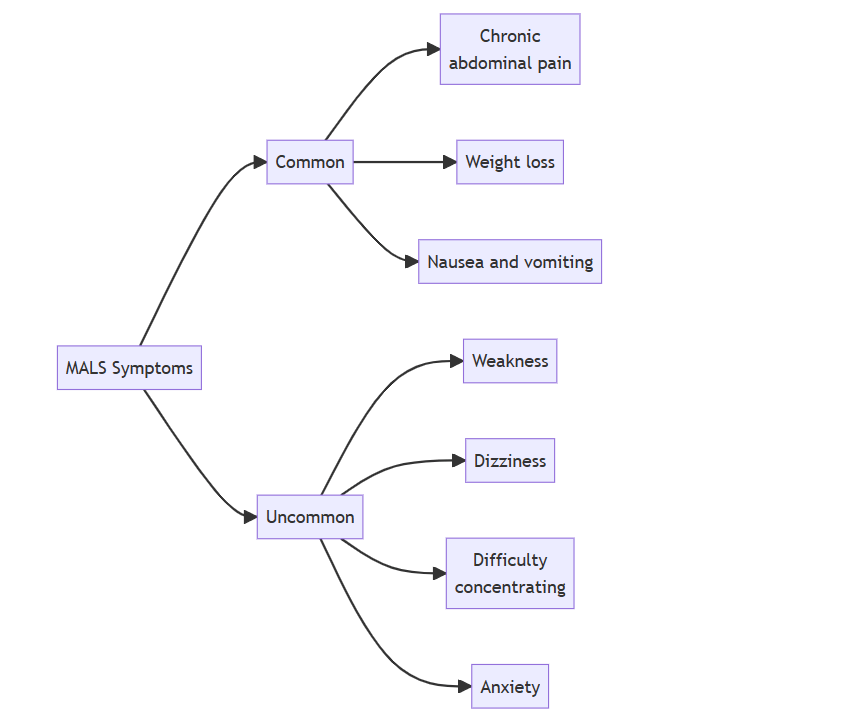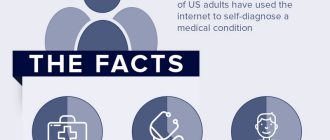Symptoms of MALS: From Chronic Abdominal Pain to Other Uncommon Manifestations.

MALS (Median Arcuate Ligament Syndrome) is a rare condition that affects a small percentage of the population. It is characterized by compression of the celiac artery caused by the median arcuate ligament, resulting in a variety of symptoms. The most common symptom of MALS is chronic abdominal pain, which can be severe and debilitating.
Chronic abdominal pain is a key manifestation of MALS and is often the first symptom to emerge. This pain may be constant or episodic, and it is typically localized to the upper abdomen. The pain is often described as a dull ache or cramping sensation, and it may be aggravated by eating or physical exertion.
In addition to abdominal pain, MALS can cause a range of other symptoms that are less commonly seen. These uncommon manifestations can vary widely from person to person and may include weight loss, nausea, vomiting, diarrhea, and early satiety.
Weight loss is one of the less common symptoms of MALS, but it can be significant in some cases. This is thought to be the result of decreased blood flow to the digestive organs, leading to malabsorption and a decrease in appetite.
Furthermore, some individuals with MALS may experience nausea and vomiting as a result of reduced blood flow to the stomach and intestines. This can lead to feelings of queasiness, an inability to tolerate certain foods, and even persistent vomiting.
Diarrhea is another uncommon symptom of MALS, although its exact cause is not fully understood. It is believed to be related to the altered blood flow and decreased absorption of nutrients in the gastrointestinal tract.
Finally, early satiety is a symptom that may occur in individuals with MALS. This refers to the feeling of fullness or satisfaction after eating only a small amount of food. This can lead to decreased appetite, weight loss, and overall diminished quality of life.
Chronic Abdominal Pain:
Chronic abdominal pain is one of the most common symptoms of MALS (Median Arcuate Ligament Syndrome). It is a condition characterized by the compression of the celiac artery due to the abnormal positioning of the median arcuate ligament. The compression of the artery can lead to various manifestations and symptoms, including:
- Abdominal pain: The pain is usually located in the upper abdomen and can be described as a constant, dull ache or a sharp, stabbing pain. It may worsen after eating or during physical activity.
- Other gastrointestinal symptoms: In addition to abdominal pain, patients with MALS may experience other gastrointestinal symptoms such as bloating, nausea, vomiting, and diarrhea. These symptoms can significantly impact the quality of life.
- Weight loss: Chronic abdominal pain and other gastrointestinal symptoms can lead to poor appetite and weight loss. This can further exacerbate the overall health and well-being of the patient.
It is important to note that chronic abdominal pain can have various causes, and it is essential to consult a healthcare professional for an accurate diagnosis. In the case of MALS, diagnostic imaging techniques such as Doppler ultrasound, computed tomography angiography (CTA), and magnetic resonance angiography (MRA) can help confirm the presence of celiac artery compression.
Treatment for chronic abdominal pain associated with MALS typically involves surgical intervention to release the compression on the celiac artery. This can be achieved through open surgical techniques or minimally invasive procedures such as laparoscopic decompression. The goal of treatment is to alleviate abdominal pain and improve overall gastrointestinal function.
In conclusion, chronic abdominal pain is one of the key manifestations of MALS. It is important to recognize the potential link between these symptoms and consider MALS as a possible diagnosis, especially in individuals who have not responded well to conventional treatments for abdominal pain.
Weight Loss:
Weight loss is another common symptom of MALS. Many patients with chronic abdominal pain caused by MALS often experience unintentional weight loss. This is due to various factors related to the condition.
One of the main reasons for weight loss in MALS patients is the chronic abdominal pain they experience. This pain can affect their appetite and ability to eat properly. The constant discomfort and pain can decrease their desire to eat, leading to a reduced calorie intake and subsequent weight loss.
In addition to the pain, MALS can also cause other manifestations that contribute to weight loss. The compression of the celiac artery by the median arcuate ligament can lead to poor blood flow to the digestive organs, affecting their normal function. This can result in a decreased absorption of nutrients from food, leading to malnutrition and weight loss.
Furthermore, MALS can cause gastrointestinal symptoms such as nausea, vomiting, and early satiety. These symptoms can further decrease the patients’ appetite and hinder their ability to maintain a healthy weight.
It is important for individuals experiencing chronic abdominal pain and other symptoms associated with MALS to seek medical attention. Proper diagnosis and treatment can help alleviate the symptoms and prevent further weight loss.
Nausea and Vomiting:
Nausea and vomiting are common symptoms experienced by individuals with MALS. These symptoms can occur as a result of the chronic abdominal pain associated with the condition. The abdominal pain caused by MALS can be intense and persistent, leading to feelings of nausea and the urge to vomit.
It is important to note that gastrointestinal symptoms, such as nausea and vomiting, can also be caused by other conditions. However, when these symptoms are present alongside other uncommon manifestations of MALS, it may indicate the involvement of the median arcuate ligament in the compression of the celiac artery. In such cases, surgical intervention may be necessary to relieve the symptoms and improve the patient’s quality of life.
In addition to nausea and vomiting, individuals with MALS may also experience other symptoms, such as weight loss, postprandial pain, and early satiety. These symptoms can further contribute to the overall discomfort and impact on daily functioning.
If you suspect that you may be experiencing symptoms of MALS, it is important to consult with a healthcare professional. They can evaluate your symptoms, perform diagnostic tests, and develop a treatment plan tailored to your specific needs.
Early Satiety:
Symptoms:
- Feeling full after eating small amounts of food
- Lack of appetite
- Difficulty finishing meals
- Nausea
- Vomiting
Chronic Abdominal Pain:
Early satiety is one of the common symptoms experienced by patients with median arcuate ligament syndrome (MALS). It refers to the feeling of fullness or the inability to eat a normal amount of food, even small portions, without feeling excessively full. This symptom can be a result of the compression of the celiac artery and subsequent reduction in blood flow to the gastrointestinal tract.
Other Uncommon Manifestations:
In addition to chronic abdominal pain and early satiety, MALS can also present with various other uncommon manifestations. These can include:
- Weight loss
- Diarrhea
- Bloating
- Malnutrition
- GERD (gastroesophageal reflux disease)
It is important to note that the symptoms of MALS can vary from person to person. Some individuals may experience only one symptom, while others may have multiple symptoms. Therefore, it is crucial to consult with a healthcare provider for an accurate diagnosis and appropriate treatment plan.
Common SymptomsUncommon Manifestations
| Chronic abdominal pain | Weight loss |
| Early satiety | Diarrhea |
| Bloating | |
| Malnutrition | |
| GERD |
Early satiety, along with chronic abdominal pain and other uncommon manifestations, can significantly impact a person’s quality of life. Proper diagnosis and management of MALS can help alleviate these symptoms and improve overall well-being.
Bowel Dysfunction:
Bowel dysfunction is one of the other uncommon symptoms of chronic abdominal pain caused by Median Arcuate Ligament Syndrome (MALS). While the main symptom of MALS is chronic abdominal pain, it can also lead to various bowel problems and dysfunctions.
Patients with MALS may experience:
- Constipation
- Diarrhea
- Irregular bowel movements
- Abdominal bloating
- Excessive gas
- Difficulty in passing stools
- Changes in bowel habits
- Feeling of incomplete evacuation
These bowel dysfunctions can vary in severity and frequency among individuals with MALS. Some patients may experience constipation as a predominant symptom, while others may have alternating episodes of constipation and diarrhea.
The exact mechanism behind bowel dysfunction in MALS is not fully understood. However, it is believed that the compression of the celiac artery by the median arcuate ligament can disrupt the blood supply to the intestines, leading to changes in bowel function.
If you are experiencing chronic abdominal pain along with bowel dysfunction, it is important to consult with a healthcare professional to determine the underlying cause. Prompt diagnosis and treatment of MALS can help alleviate symptoms and improve quality of life.
Malnutrition:
Malnutrition is one of the uncommon symptoms associated with MALS. Chronic abdominal pain can lead to a decreased appetite and difficulty eating, resulting in poor nutrition and malnutrition. The persistent pain and discomfort can make it challenging for individuals with MALS to consume an adequate amount of food, leading to weight loss and nutritional deficiencies.
Malnutrition can further exacerbate the symptoms of MALS, as the body may not have the necessary nutrients to support proper functioning. This can lead to fatigue, weakness, and a compromised immune system, making individuals with MALS more susceptible to infections and other health complications.
The specific nutritional deficiencies that may occur in individuals with MALS can vary. However, common deficiencies include vitamins, such as vitamin D, vitamin B12, and iron. These nutrients are essential for various bodily functions, including bone health, red blood cell production, and energy metabolism. Without an adequate intake of these nutrients, individuals with MALS may experience additional symptoms, such as fatigue, brittle bones, and anemia.
Managing malnutrition in individuals with MALS involves a multifaceted approach. It typically involves working with a healthcare team, including a gastroenterologist and a registered dietitian, to develop a customized nutrition plan. This plan may involve focusing on nutrient-dense foods, such as fruits, vegetables, lean proteins, and whole grains, to ensure individuals meet their nutritional needs. In some cases, nutritional supplements may also be recommended to help address specific deficiencies.
Delayed Gastric Emptying:
Delayed gastric emptying, also known as gastroparesis, is one of the uncommon manifestations of Median Arcuate Ligament Syndrome (MALS), a condition characterized by chronic abdominal pain. It occurs when the muscles in the stomach are unable to contract properly, resulting in slow digestion and emptying of food from the stomach into the small intestine.
Patients with MALS may experience symptoms related to delayed gastric emptying, including:
- Feeling full quickly after eating small amounts of food
- Nausea and vomiting
- Abdominal bloating
- Heartburn or acid reflux
- Poor appetite
These symptoms can be debilitating and significantly impact a person’s quality of life. Treatment for delayed gastric emptying associated with MALS may involve dietary modifications, medications to promote gastric motility, and in severe cases, surgical intervention to relieve the compression of the celiac artery and restore proper blood flow.
Delayed Gastric Emptying SymptomsMALS-associated
| Feeling full quickly after eating | + |
| Nausea and vomiting | + |
| Abdominal bloating | + |
| Heartburn or acid reflux | + |
| Poor appetite | + |
If you are experiencing chronic abdominal pain and other uncommon symptoms like delayed gastric emptying, it is important to consult with a healthcare professional to determine the underlying cause and receive appropriate treatment.
Postprandial Diarrhea:
One of the common symptoms of MALS is chronic abdominal pain, which can be debilitating for patients. However, there are also other uncommon manifestations of this condition, one of which is postprandial diarrhea.
Postprandial diarrhea is a type of diarrhea that occurs after eating a meal. Patients with MALS may experience loose, watery stools shortly after consuming food. This can be distressing and disruptive to daily life.
The mechanism behind postprandial diarrhea in MALS is not fully understood. However, it is believed to be related to the compression of the celiac artery by the median arcuate ligament. This compression can lead to reduced blood flow to the intestines, resulting in digestive abnormalities such as diarrhea.
Postprandial diarrhea can be difficult to manage, as it often requires dietary modifications. Patients may need to avoid certain trigger foods that worsen their symptoms. It is also important for patients to stay hydrated and replenish their electrolytes, as frequent diarrhea can lead to dehydration.
If you are experiencing chronic abdominal pain along with postprandial diarrhea, it is important to consult with a healthcare professional. They can help diagnose the underlying cause of your symptoms and develop an appropriate treatment plan.
Intolerance to Fatty Foods:
One of the manifestations of MALS is an intolerance to fatty foods. This symptom can be a result of the chronic abdominal pain experienced by those with MALS.
Chronic abdominal pain is a common symptom of MALS, and it can be debilitating for those who suffer from it. The pain is often described as a constant ache or a burning sensation in the upper abdomen. It can also be accompanied by bloating, indigestion, and nausea.
When someone with MALS eats fatty foods, their body may have difficulty digesting and absorbing the fat. This can lead to uncomfortable and unpleasant symptoms such as diarrhea, gas, and bloating. The body may also have difficulty breaking down the fat, which can cause it to pass through the digestive system undigested.
It is important for individuals with MALS to be aware of their intolerance to fatty foods and make dietary adjustments accordingly. This may include reducing the amount of fat in their diet or avoiding certain types of fatty foods altogether.
MALS can cause a range of symptoms beyond chronic abdominal pain, and intolerance to fatty foods is just one of many possible manifestations. It is important for individuals with MALS to work closely with their healthcare team to manage their symptoms and develop a personalized treatment plan.
Episodic Abdominal Pain:
One of the common symptoms of Median Arcuate Ligament Syndrome (MALS) is chronic abdominal pain. However, in some cases, the pain experienced by individuals with MALS can be episodic rather than constant.
Episodic abdominal pain is characterized by periods of intense pain followed by periods of relief. These episodes can last for a few minutes to several hours and can occur multiple times a day or on an infrequent basis.
The pain experienced during these episodes is often described as sharp, cramping, or stabbing. It may be localized to the upper abdomen, but can also radiate to the back or chest.
What sets episodic abdominal pain in MALS apart from other types of abdominal pain is its association with specific triggers. Certain activities, such as eating a meal or engaging in physical exertion, can trigger an episode of pain. The pain may also be worsened by lying down or by stress.
It is important to note that episodic abdominal pain is just one of the many uncommon manifestations of MALS. Other symptoms may include weight loss, nausea, vomiting, and food intolerance.
Due to the presence of these unique symptoms, MALS can be challenging to diagnose, and individuals may undergo a variety of tests before a definitive diagnosis is made. Diagnostic tools such as imaging studies, mesenteric Doppler ultrasound, and angiography can be used to evaluate the blood flow to the abdominal organs and identify any abnormalities.
Treatment for MALS often involves surgical intervention to relieve the compression of the median arcuate ligament on the celiac artery. This can be done through various minimally invasive techniques, such as laparoscopic or robotic-assisted surgery.
Symptoms of MALS:Common SymptomsUncommon Manifestations
| Chronic abdominal pain | Episodic abdominal pain |
| Weight loss | Nausea |
| Food intolerance | Vomiting |
In conclusion, episodic abdominal pain is a specific type of pain experienced by individuals with MALS. It is characterized by intermittent episodes of intense pain triggered by certain activities. Recognizing this symptom, along with other uncommon manifestations, can help healthcare professionals make a timely and accurate diagnosis of MALS.
Lack of Appetite:
A lack of appetite is an uncommon symptom that can be associated with chronic abdominal pain in patients with MALS. While most people might assume that abdominal pain would naturally decrease one’s appetite, this is not always the case. Some individuals with MALS may experience a lack of appetite, despite having ongoing pain in their abdomen.
This lack of appetite can be a result of various factors related to MALS. First, the chronic abdominal pain can make it uncomfortable or painful to eat, leading to a reduced desire for food. Additionally, the presence of other symptoms such as nausea or bloating can further contribute to the lack of appetite.
It is important to note that a lack of appetite can also be a symptom of other medical conditions unrelated to MALS. Therefore, it is crucial for patients experiencing this symptom to consult with their healthcare provider for a proper diagnosis and appropriate treatment.
Epigastric Pain:
Epigastric pain is one of the common symptoms experienced by patients with MALS. It is characterized by a persistent discomfort or pain in the upper abdomen, specifically in the epigastric region. This pain may vary in intensity and may be dull, aching, or sharp.
In some cases, the epigastric pain may radiate to other parts of the abdomen or even to the back. This can make it difficult for patients to localize the source of their pain.
Patients with MALS often describe their epigastric pain as a constant or intermittent sensation that worsens after eating or with physical activity. The pain may also be accompanied by other gastrointestinal symptoms such as bloating, nausea, and vomiting.
It is important to note that while epigastric pain is a common manifestation in MALS, it can also be associated with other medical conditions. Therefore, it is always advisable to consult with a healthcare professional for an accurate diagnosis and appropriate treatment.
Nutrient Deficiencies:
Chronic abdominal pain and other uncommon manifestations of Median Arcuate Ligament Syndrome (MALS) can result in nutrient deficiencies due to a variety of factors.
Firstly, the persistent pain associated with MALS can significantly impact appetite and food intake. Many individuals with MALS experience a decrease in appetite and may avoid eating due to the fear of triggering abdominal pain. This can lead to a reduced intake of essential nutrients, such as proteins, vitamins, and minerals.
Furthermore, the chronic abdominal pain caused by MALS can also affect the digestion and absorption of nutrients. The constant tension on the arteries and surrounding tissues can impair the proper functioning of the gastrointestinal system, leading to malabsorption issues.
In addition, the uncommon manifestations of MALS, such as nausea and vomiting, can further contribute to nutrient deficiencies. These symptoms can interfere with the normal digestion and absorption of nutrients, resulting in a lack of essential vitamins and minerals.
Some of the common nutrient deficiencies observed in individuals with MALS include iron deficiency anemia, vitamin B12 deficiency, and vitamin D deficiency. These deficiencies can lead to a range of symptoms, including fatigue, weakness, and impaired immune function.
Individuals with MALS must work closely with healthcare professionals, such as dietitians, to ensure they are meeting their nutritional needs. A well-balanced diet and, in some cases, nutritional supplements may be necessary to address nutrient deficiencies and promote overall health and well-being.
Common Nutrient Deficiencies:Symptoms:
| Iron deficiency anemia | Fatigue, weakness, pale skin |
| Vitamin B12 deficiency | Tingling or numbness in extremities, fatigue, weakness |
| Vitamin D deficiency | Weakness, muscle pain, increased susceptibility to infections |
It is important for individuals with MALS to monitor their nutrient levels regularly and seek appropriate medical guidance. Diet modifications, supplements, and other interventions can help address nutrient deficiencies and improve overall health outcomes.
Heartburn and GERD:
Heartburn is a common symptom of gastroesophageal reflux disease (GERD), which is a condition where stomach acid flows back into the esophagus. While heartburn can occur in individuals without MALS, it is a manifestation that may be present in some patients with MALS.
In individuals with MALS, the chronic abdominal pain may extend to the upper abdomen and chest, leading to symptoms similar to heartburn. This can be confusing, as the pain is not originating from the stomach or esophagus but is a result of MALS.
Other uncommon manifestations of MALS can include difficulty swallowing, nausea, vomiting, and weight loss. These symptoms may be intermittent or chronic, and can significantly impact a person’s quality of life.
It is important to note that not all individuals with MALS will experience these symptoms. Some may only have mild abdominal pain, while others may have more severe and debilitating symptoms.
If you are experiencing symptoms such as chronic abdominal pain, heartburn, or other uncommon manifestations, it is important to consult with a healthcare professional. They can evaluate your symptoms and determine the best course of action for diagnosis and treatment, which may include further tests or surgical intervention.
Malabsorption:
In addition to chronic abdominal pain, patients with MALS may also experience other symptoms that are less common and may not be immediately associated with the condition. One of these symptoms is malabsorption.
Malabsorption refers to the body’s inability to properly absorb nutrients from the digestive tract. This can lead to deficiencies in essential vitamins, minerals, and other nutrients necessary for the body to function properly.
Patients with MALS may experience malabsorption due to the compression of the celiac artery, which can affect the blood flow to the small intestine. This can result in a decreased ability to absorb nutrients from the food that is consumed.
Common symptoms of malabsorption in patients with MALS may include:
- Chronic diarrhea or loose stools
- Steatorrhea (fatty, greasy stools)
- Weight loss
- Weakness and fatigue
- Vitamin deficiencies
- Anemia
It is important for patients with MALS who experience symptoms of malabsorption to seek medical attention. A healthcare professional can perform tests to diagnose malabsorption and provide appropriate treatment, which may include dietary modifications and supplementation.
Abdominal Distention:
Abdominal distention is another uncommon symptom associated with MALS. It refers to the abnormal swelling or enlargement of the abdomen.
Patients with chronic abdominal pain due to MALS may also experience abdominal distention as one of their manifestations. The distention can range from mild to severe, causing discomfort and a visible protrusion of the abdomen.
The exact cause of abdominal distention in MALS is not yet fully understood, but it is believed to be related to the compression and decreased blood flow in the celiac artery. This compression can lead to a buildup of gas and fluid in the abdomen, resulting in distention.
Abdominal distention can be particularly bothersome for patients with MALS, as it can interfere with daily activities and affect their quality of life. In some cases, the distention may also be accompanied by other symptoms such as bloating, nausea, and constipation.
Treatment for abdominal distention in MALS focuses on addressing the underlying cause of the condition, which is the compression of the celiac artery. This may involve surgical intervention to relieve the pressure on the artery and restore normal blood flow to the abdomen.
Overall, while abdominal distention is an uncommon symptom of MALS, it can significantly impact the lives of affected individuals. Recognizing and addressing this symptom, along with other manifestations of MALS, is crucial for accurate diagnosis and appropriate management of the condition.
Discomfort with Eating:
One of the primary symptoms of MALS is discomfort or pain while eating. This can manifest as a feeling of fullness, bloating, or a general discomfort in the abdomen. Individuals with MALS may also experience difficulty swallowing or a sensation that food is getting stuck in their throat.
In addition to these common manifestations, there are other, more uncommon symptoms that can occur when individuals have MALS. These can include:
- Nausea and vomiting
- Weight loss
- Heartburn or acid reflux
- Chest pain
- Diarrhea or constipation
- Intolerance to fatty foods
- Muscle weakness
It is important to note that these symptoms can vary from person to person, and not everyone with MALS will experience all of them. Some individuals may only have one or a few symptoms, while others may have a combination of several.
If you are experiencing chronic abdominal pain or any of these symptoms, it is important to speak with a healthcare provider. They can help determine the cause of your discomfort and develop a treatment plan that is tailored to your specific needs.
Flatulence and Bloating:
Flatulence and bloating are common symptoms experienced by individuals with chronic abdominal pain caused by Median Arcuate Ligament Syndrome (MALS). MALS is a condition characterized by compression of the celiac artery by the median arcuate ligament, resulting in reduced blood flow to the organs of the gastrointestinal system.
Flatulence refers to the excessive presence of gas in the digestive tract, leading to the release of gas through the rectum. This can result in a feeling of fullness, discomfort, and the need to pass gas frequently. Bloating, on the other hand, refers to a sensation of abdominal fullness or distention which often occurs due to the buildup of gas in the digestive system.
Individuals with MALS may experience flatulence and bloating as a result of the abnormal functioning of the gastrointestinal system. The compression of the celiac artery can disrupt the normal digestive process, leading to the accumulation of gas in the intestines. This can cause discomfort and pain.
In addition to flatulence and bloating, individuals with MALS may experience other symptoms such as chronic abdominal pain, weight loss, nausea, vomiting, and diarrhea. These symptoms can vary in severity and may worsen after eating. Other less common manifestations of MALS include dizziness, weakness, and fatigue.
It is important for individuals experiencing chronic abdominal pain, flatulence, and bloating to consult a healthcare professional for a proper diagnosis and treatment. MALS can be diagnosed through various imaging tests and treatment options may include medication, dietary changes, or surgery to relieve the compression of the celiac artery.
Overall, flatulence and bloating are common symptoms experienced by individuals with MALS, along with other manifestations of the condition. Seek medical attention if you are experiencing these symptoms to receive appropriate care.
Question-answer:
What are the common symptoms of MALS?
The common symptoms of MALS include chronic abdominal pain, weight loss, nausea, vomiting, diarrhea, and bloating.
Can MALS cause other uncommon manifestations besides chronic abdominal pain?
Yes, MALS can cause other uncommon manifestations including fatigue, dizziness, lightheadedness, difficulty concentrating, and anxiety.
How is MALS diagnosed?
MALS is typically diagnosed through a combination of medical history, physical examination, imaging tests such as CT angiography or Doppler ultrasound, and possibly angiography.
What is the treatment for MALS?
The treatment for MALS usually involves surgical intervention, typically in the form of laparoscopic or open surgery to release the compression of the celiac artery. In some cases, medications may also be used to manage symptoms.
Is MALS a rare condition?
MALS is considered a rare condition, although its true prevalence is not well known due to the underdiagnosis and misdiagnosis of the condition. It is more commonly seen in women and often affects younger individuals.
What are the symptoms of MALS?
Common symptoms of MALS include chronic abdominal pain, weight loss, nausea, and vomiting. Patients may also experience a variety of uncommon manifestations such as postprandial pain, abdominal bruit, and gastrointestinal bleeding.






